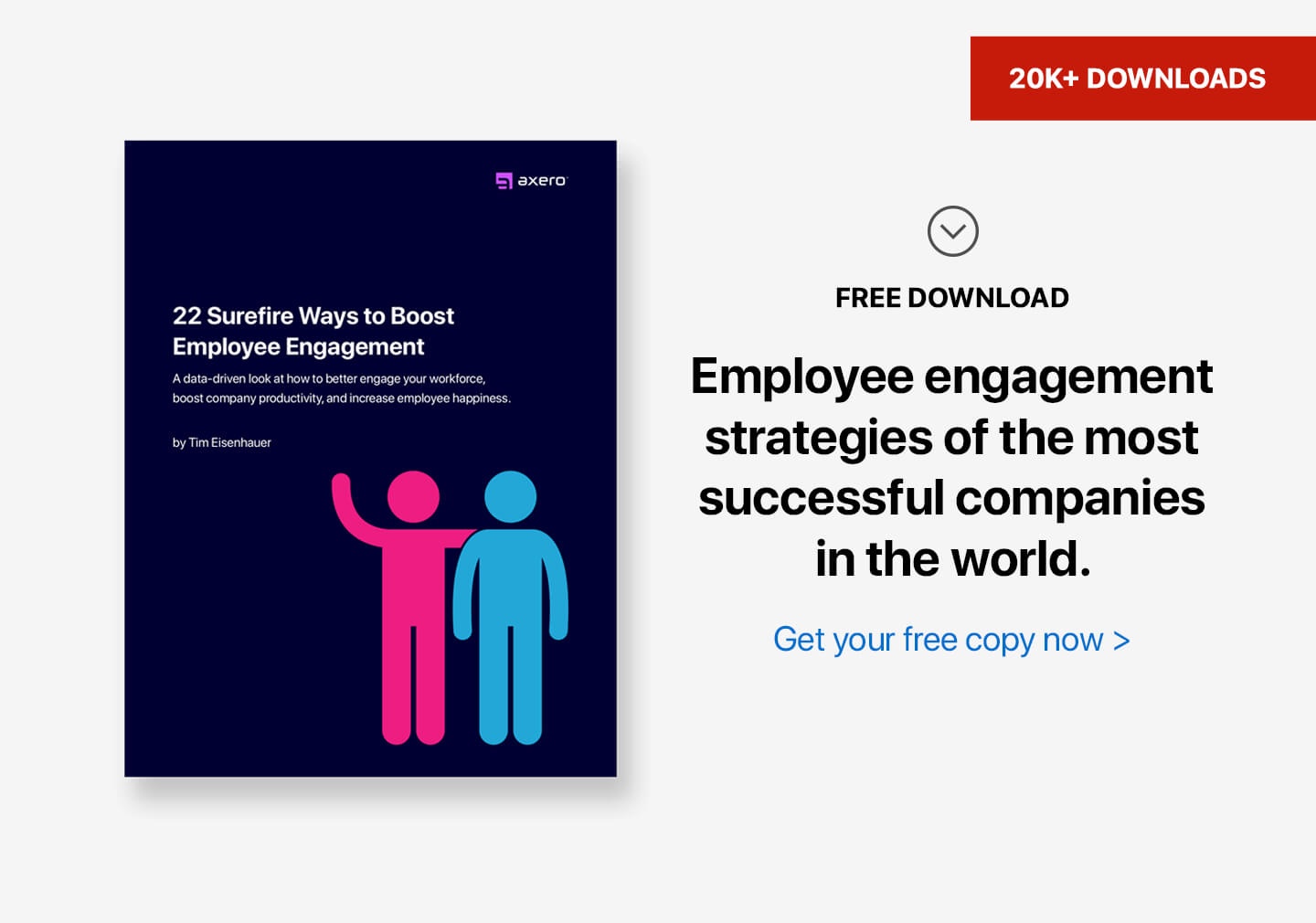“Employees who cannot work together respectfully. (I’m a new supervisor trying to pull together a team that has a history of not working well together.)”
— Social Work Supervisor
As a manager, not only do you need all kinds of people to work for you—sometimes you need them to work for you together.
Working together is presumably why people join a company as opposed to striking out on their own. However, it doesn’t stop them from engaging in selfish and uncooperative behaviors once they are safely installed in their offices and cubicles.
I find it interesting that this Social Work Supervisor came to an employee engagement site to seek a solution to her challenge. Does engagement help people get along? Or is a driven employee even more likely to make enemies at work than the one sitting back and collecting paychecks?
As we’ll see later in this post, employee engagement principles can overcome hostility in the workplace. However, it is also true that disengaged employees frequently bond together, while their more motivated colleagues butt heads with each other.
When two people are passionately opposed to working well together, they are likely to be equally passionate about something else. They may be concerned for the well-being of the company. They may hang a lot of hopes on the outcome of a project. Or they may look out for their own job security and career prospects. The point is both of these sworn enemies are likely to care deeply about their jobs.
As a manager, your job is to keep that passion burning, while tactfully removing the obstacles to cooperation. These obstacles will vary case by case, so your listening skills will come in handy. However, there will also be some common themes. Let’s see if we can find any that might help our Social Work Supervisor restore sanity within her team.
She is facing a peculiar challenge: social workers who “cannot work together respectfully.” I did not make that up! Somewhere in the world, there is a group of licensed professionals who teach social skills for a living and help other people integrate into society—who have trouble showing a little respect for each other.
How is it possible that people who obviously know better cave to their lowest instincts? To answer this question, let’s take an extreme case of workplace murder.
Although rare, murders of college professors by college professors are not unheard of. There was the 1992 case of Dr. Valery Fabrikant, an associate professor of mechanical engineering at Concordia University in Montreal. Dr. Fabrikant is now serving a life sentence for the shooting deaths of his department chair and three of his colleagues.
Then there was the 2010 case of Dr. Amy Bishop, a biology professor at the University of Alabama in Huntsville. Dr. Bishop brought a 9-millimeter handgun to a routine departmental meeting and opened fire on her esteemed colleagues, killing the department head and two others.
In 2016, Dr. Edward Gutting, an instructor at Missouri State University, broke into the home of his colleague, a retired history professor Marc Cooper, with a butcher knife and stabbed him to death.
If you are wondering whether there were any similarities among these murders—beyond the obvious—there were. In fact, all three perpetrators shared the same motive. All were talented, ambitious individuals who took their jobs seriously. Maybe a little too seriously. All worked hard toward a coveted tenure spot. All were rejected—unfairly, in their minds. Finally, all three blamed their coworkers for killing their dream.
None of this explains or justifies an act of murder, or even a thought of committing such an act. Ultimately, it was something inside the culprit’s mind that drove him or her over the edge. However, if we take the murderer’s personality out of the equation, what do we see?
Every murder was preceded by months, if not years, of building pressure and resentment. So, it might be fair to say that all parties acted destructively, even though, for the time being, it took the familiar form of “not working together respectfully.” Moreover, the main ingredients of toxic work culture were already present before either the murderers or their victims appeared on the scene.
I am thinking about two, in particular: secrecy and competition.
Tenure is the holy grail of an academic career. It offers lifelong employment and freedom to conduct your own research. On the flip side, the path to tenure is difficult and nerve-wracking. Once hired into a tenure-track position, a candidate has six years to prove himself. During this period, he must meet many requirements and make many friends. However, no accomplishment guarantees success. At the end of the trial period, the tenured faculty vote to recommend or deny tenure. Because the vote is anonymous, the professors need not justify their choice to the candidate or anyone else.
So, on the one hand, you’ve got a fiercely competitive process, where the candidate compares himself to his colleagues to gauge his own performance. On the other, no objective measure of success exists, so the losers are left guessing why they came up short.
Competition breeds hostility. In one of my favorite books, Influence, Robert Cialdini describes a series of social experiments conducted at a boys’ summer camp. He sums it up:
“…the recipe for disharmony was quick and easy. Just separate the participants into groups and let sit for a while in their own juices. Then mix together over a flame of continued competition. And there you have it: cross-group hatred at a rolling boil.”
A university department may not look like a bunch of adolescent campers playing tug-of-war, cabin against cabin. On second thought, who knows what kinds of internal politics are brewing beneath the surface? It doesn’t take much to create an “us” vs. “them” culture. It could be the tenured faculty vs. the non-tenured. Or it could be one professor’s lab against another’s. In the worst case, it is one desperate individual against the world. According to some first-hand accounts, that’s what tenure denial feels like.
But let’s come back to our Social Work Supervisor. Could some of this explain the behavior of her team? Is there an ego contest going on? Is anything substantial at stake? Money? Promotions? Professional reputation? We know that the Supervisor is a new hire. Were the employees eyeing the opening for themselves? Do they blame each other for losing the job to an outsider? And what can she do now to clear the air in the office?
The second part of the boys’ camp experiment may give us a hint. After sowing discord between the two cabins, the researchers wanted to get the boys to become friends. To achieve this goal, they created a few emergencies that required everyone to work together. In one instance, the single truck available to go into town for food “accidentally” got stuck, and all the boys had to pull and push until they got it to move. Another time, the boys learned that the camp could not afford to rent the movie everyone wanted to see. The only solution was for all the boys to pool their money together to pay for the movie, which was exactly what they did.
This experiment went so well that, in the end, one cabin used the leftover money to treat their former enemies to milkshakes! Can a similar strategy work with busy adults?
For many companies, the answer is yes. That’s why they volunteer together. Some companies even pay their employees to do so. They believe that working together for a charitable cause allows the employees to get to know each other as helpful and caring individuals—something they may not see in the office. Corporate volunteering takes some creativity and know-how. If you want to learn more, check out Chapter 22, Engage Outside of Work, in Who the Hell Wants to Work for You?
Competitive culture encourages us to project our frustrations and fears onto others, creating barriers to genuine cooperation. Same goes for secrecy. In fact, many universities now understand this point and are making the tenure process as transparent as possible. A typical candidate has many opportunities to receive feedback and is not surprised by the final decision.
What about our Social Work Supervisor? In addition to helping her people get to know each other, can she remove some unnecessary mystery from their jobs? Does everyone understand how cases are assigned? How pay raises are calculated? And how the management makes decisions that matter to employees?
Of course, there are many more obstacles to cooperation than the two we’ve just discussed. In the next post, we’ll look into coworkers with conflicting methods and goals. And ask whether non-cooperation is ever a good idea.
_____
If you want your employees to work well together, you might like my book, because it explains the drivers and the barriers to cooperation in the workplace.












 info@axerosolutions.com
info@axerosolutions.com 1-855-AXERO-55
1-855-AXERO-55


